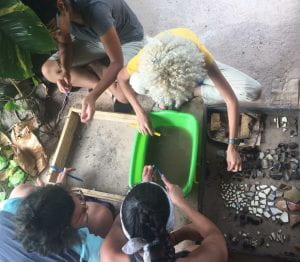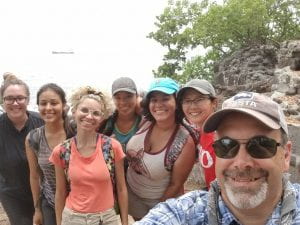By Gabriela Gutierrez
My name is Gabriela Gutierrez. I was born and raised in San Antonio, Texas and am currently a sophomore/junior at Texas State University pursuing a degree in anthropology. When presented with an opportunity to apply to the Research Experience for Undergraduates archeology program, I applied and was accepted. I am a cultural anthropology major and although this was an archeological experience, I applied anyway since I believe that having experience in every branch of anthropology creates an outstanding anthropologist. This experience will provide another perspective to my studies.
While in St. Eustatius, the group left for field work at 7 am and worked Monday – Friday (and at times, even Saturday). Our days consisted of using trowels and brushes to level out the sand or dirt in order to reveal artifacts. We troweled the dirt into a dust pan and placed it into a bucket. From the bucket, the group screened the dirt for artifacts, which we then placed in specifically identified bags. Usually after field work, the group went to St. Eustatius Center for Archeological Research (SECAR) to clean and bag artifacts from previous days. We were also instructed to keep a journal that we recorded in daily. This journal served a great deal of help later on in our research.
St. Eustatius, the group left for field work at 7 am and worked Monday – Friday (and at times, even Saturday). Our days consisted of using trowels and brushes to level out the sand or dirt in order to reveal artifacts. We troweled the dirt into a dust pan and placed it into a bucket. From the bucket, the group screened the dirt for artifacts, which we then placed in specifically identified bags. Usually after field work, the group went to St. Eustatius Center for Archeological Research (SECAR) to clean and bag artifacts from previous days. We were also instructed to keep a journal that we recorded in daily. This journal served a great deal of help later on in our research.
This research opportunity was filled with knowledge. It was an experience that is now a significant part of my anthropological career and serves as preparation for what is to come in my future. I learned the steps that go into creating a research design, it is more than just googling topics. The research is very extensive, as it begins before excavating. Our group received a tour of St. Eustatius and the tour guide provided us with a brief history of the island to give us an idea of the artifacts we would be working with so that way it would be easier to make connections between the past and what it meant for the present. We also learned more about the island during our excavation as we found artifacts. Our group used articles to do research to aid in our comparisons of our examinations of the artifacts found. Many times, these articles aided us in identifying certain ceramics and provided extra background information on St. Eustatius and St. Kitts.
I am  extremely appreciative to have been accepted into such a program at such an early stage in my career. This research experience will enable me to complete my future cultural studies with new insights, and it sets the foundation for a versatile anthropologist. I am currently working with my colleague, Kaylee Gaumnitz, on a comparative analysis between the ceramic artifacts found on St. Eustatius and those from St. Kitts. Our goal is to see where these ceramic sherds originate from. In so doing, we will be able to determine which counties the island of St. Eustatius traded with, and we hope to emphasize the long-term effects of globalization and colonization.
extremely appreciative to have been accepted into such a program at such an early stage in my career. This research experience will enable me to complete my future cultural studies with new insights, and it sets the foundation for a versatile anthropologist. I am currently working with my colleague, Kaylee Gaumnitz, on a comparative analysis between the ceramic artifacts found on St. Eustatius and those from St. Kitts. Our goal is to see where these ceramic sherds originate from. In so doing, we will be able to determine which counties the island of St. Eustatius traded with, and we hope to emphasize the long-term effects of globalization and colonization.
